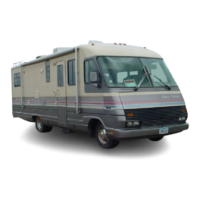17
Discovery, Discovery LXE, Pace Arrow, and Pace Arrow LXEt
Step 1:
For the best possible protection
keep infants in the back seat, in
rear-facing child safety seats,
as long as possible up to the
height or weight limit of
the particular seat. At a
minimum, keep infants
rear-facing until a minimum
of age 1 and at least 20
pounds.
Step 2:
When children outgrow their
rear-facing seats (at a minimum
age 1 and at least 20 pounds) they
should ride in forward-facing
child safety seats, in the back seat,
until they reach the upper
weight or height limit of
the particular seat (usually
around age 4 and 40
pounds).
Step 3:
Once children outgrow their
forward-facing seats (usually
around age 4 and 40 pounds),
they should ride in booster seats,
in the back seat, until the vehicle
seat belts t properly. Seat belts
t properly when the lap
belt lays across the upper
thighs and the shoulder
belt ts across the chest
(usually at age 8 or when
they are 4', 9" tall).
Step 4:
When children outgrow
their booster seats, (usually
at age 8 or when
they are 4’9” tall)
they can use the
adult seat belt in
the back seat, if it
ts properly (lap belt lays across
the upper thighs and the shoulder
belt ts across the chest). All
children under age 13 should ride
in the back seat.
NOTE:
The motorhome
manufacturer is not the
author of Child Passenger
Safety. The information
provided is reprinted
from the National
Highway Traffic Safety
Administration’s website.
Visit NHTSA’s website
at www.nhtsa.gov for the
most recent and up to date
information.
Tips:
Go to www.nhtsa.gov
and choose “Child Safety
Seat Information” from
the menu or click on the
child passenger safety icon.
The site includes child
safety seat installation tips,
product ratings, recalls and
other useful information.
For more information about
child safety seats, booster
seats, inspection/tting
stations in your area, seat
belts, and other highway
safety issues, call the DOT
Vehicle Safety Hotline at:
1-888-327-4236.
A certied child passenger
safety technician can check
your installation and answer
questions. To nd a technician
or an inspection station near
you, go to www.nhtsa.gov,
click on the child passenger
safety icon, and then click on
the Fitting/Inspection Station
link, or go to www.seatcheck.
org.
The child safety seat can be
positioned in two places: the
front passenger (co-pilot) seat
and forward facing permanently
mounted booth dinette seat
equipped with safety belts.
WARNING:
Individual states and
Canadian provinces may
have laws that can exceed
the requirements as
described in this section. It
is the responsibility of the
owner to know and comply
with the laws in the state
or province in which the
motorhome will travel.
NOTE:
Use of a safety or booster
seat in the front seat may
be prohibited in some states
and Canadian provinces.
WARNING:
Do not transport children
unrestrained. Infants must
be placed in approved safety
seats - small children must
be restrained in child safety
seats. Do not use a single seat
belt on more than one child.
Failure to comply with these
rules can lead to injury or
death.
020356
020355

